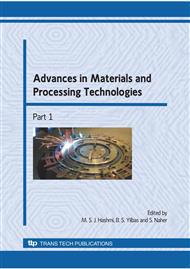p.281
p.289
p.295
p.303
p.315
p.326
p.335
p.342
p.350
Modeling the Force, Surface Roughness and Cutting Temperature in Ultrasonic Vibration-Assisted Turning of Al7075
Abstract:
The single point cutting tool in ultrasonic vibration-assisted turning (UAT) is made to vibrate under ultrasonic frequency. In present study, the influence of various parameters such as vibration amplitude, depth of cut, feed rate and cutting velocity on the machining force and workpiece's surface roughness in UAT of Al7075 has been investigated. Full factorial experiments were carried out with an ultrasonic frequency range of 20±0.5 kHz. ANOVA was conducted on the experimental results and regression models were obtained for predicting the machining force, surface roughness and cutting temperature. The proposed models were verified by further experiments. The robustness of the proposed models was then investigated whence the optimal parameters were estimated. Similar full factorial experiments were also carried out with conventional turning (CT) in order to compare the results with those of UAT.
Info:
Periodical:
Pages:
315-325
Citation:
Online since:
December 2009
Authors:
Price:
Сopyright:
© 2010 Trans Tech Publications Ltd. All Rights Reserved
Share:
Citation:


